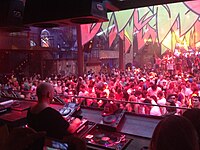Drop Bass Network Records

DJ Sven Väth mixes tracks for a crowd of dancers at Amnesia, an Ibiza nightclub, in 2013.
|
|
| General Information | |
|---|---|
| Genres included |
|
| Related genres | |
| Location | Worldwide |
| Types of street rave dance | |
| Related events | |
| Related topics | |
A rave (from the verb: ) is a large dance party at a nightclub, dance club or festival featuring performances by DJs, who select and mix a seamless flow of loud electronic dance music songs and tracks. DJs at rave events play electronic dance music on vinyl, CDs and digital audio from a wide range of genres, including house, trance, techno, hardcore, breakbeat and electro-industrial. Occasionally live performers playing synthesizer or other electronic instruments will play electronic music. The music is amplified with a large, powerful sound reinforcement system, typically with huge subwoofers to produce a deep bass sound. The music is often accompanied by laser light shows, projected coloured images, visual effects and fog machines.
While some raves may be small parties held at nightclubs or private homes, some raves have grown to immense size, such as the large festivals and events featuring multiple DJs and dance areas (e.g., the Castlemorton Common Festival in 1992). Some electronic dance music festivals have features of raves, but on a larger, often commercial scale. Raves may last for a long time, with some events continuing for twenty-four hours, and lasting all through the night. Law enforcement raids and anti-rave laws have been used against the rave scene in many countries. This is due to the association of illegal club drugs such as MDMA (ecstasy) and party drugs (such as BZP), and the use of non-authorized, secret venues for some raves, such as squat parties at unused warehouses or aircraft hangars. In part, this is due to the media attention and moral panic that has arisen when ever rave participants have adverse drug reactions.
...
Wikipedia
